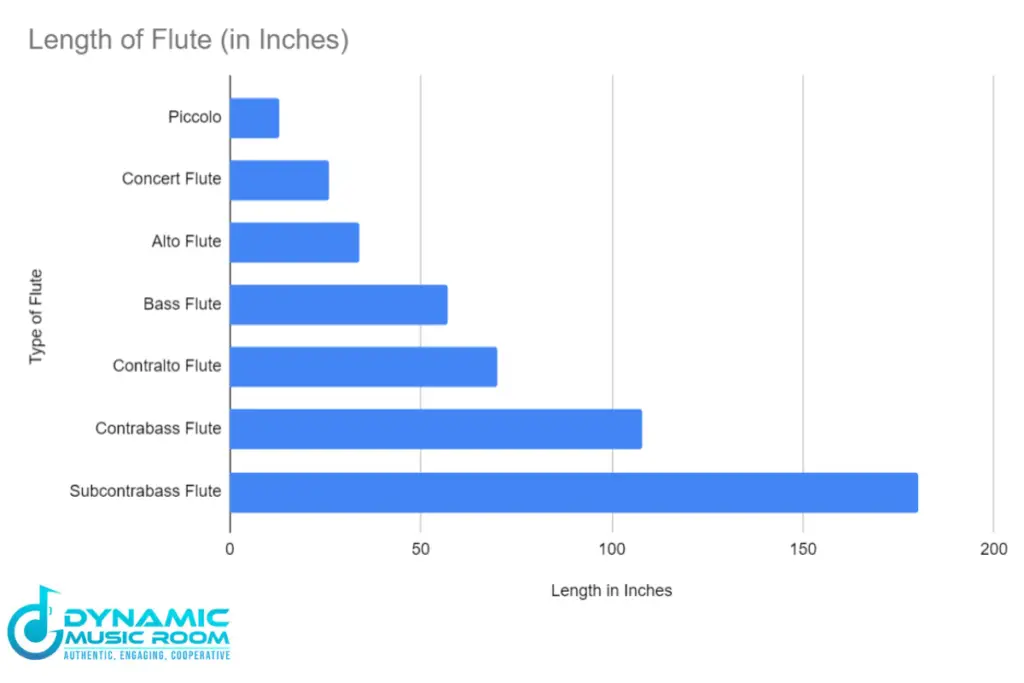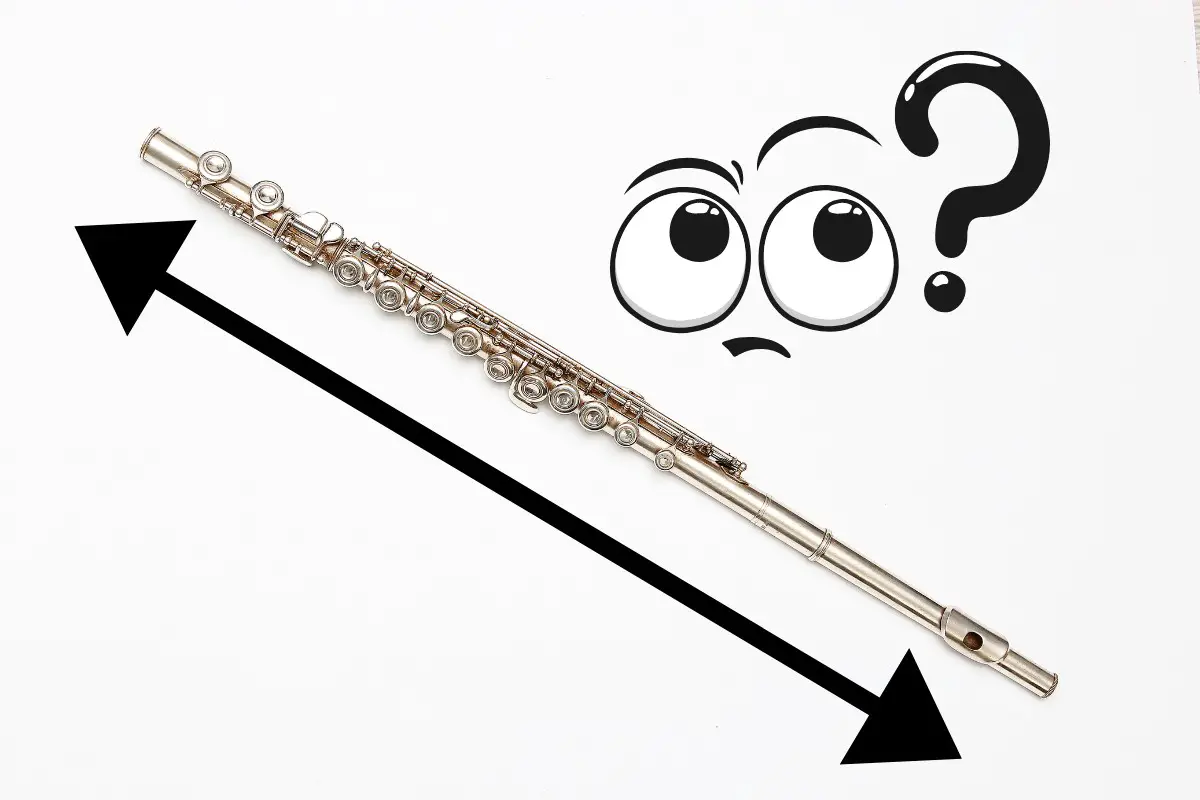Students, parents, and new musicians always want to more about the musical instruments they’re interested in.
But do you how much space the standard flute and its family take up? I did the research over many types of flutes and came up with the answer, so you don’t have to wonder anymore.
The standard C flute is 26 in (67 cm) long. Overall, the smallest member of the family (the piccolo) is 13 in (33cm), and the largest member, the subcontrabass flute, is 15 ft (4.6 m) long.
Let’s look at all the members of the flute family and their sizes side by side.
Table of Contents
Length Of Flutes Side By Side
These are the average length of each type of musical instrument.
On the whole, a cheap and quality flute will be almost the exact same length.
| Type Of Flute | Length in Inches or Feet | Length in Centimeters or Meters |
|---|---|---|
| Piccolo | 13 in | 33 cm |
| Concert Flute | 26 in | 67 cm |
| Alto Flute | 34 in | 86 cm |
| Bass Flute | 57 in | 1.46 m |
| Contralto Flute | 70 in | 1.78 cm |
| Contrabass Flute | 9 ft | 2.74 m |
| Subcontrabass Flute | 15 ft | 4.6 m |
How Do You Play Such A Long Flute?
While not a problem with the standard soprano flute, the bass and above sizes may seem impossible for the flute players to hold, let alone reach all the finger holes.
These lengths are accurate, but they don’t reflect the design of the woodwind instrument. Starting even with the alto flute, all of these wind instruments feature curves and turns to make them more holdable.
The largest flutes sit on the ground and twist around in a triangular shape to position the embouchure hole right at your level when sitting or standing. You don’t hold these at all.
Then, as with any band flute, you use keys to press and cover the tone holes.
All this being said, a beginner flute will usually be the soprano/concert flute because it’s the easiest to hold and play and the most common type.

Flute Sizes Compared With Other Objects
All of the above numbers are great, but what does it mean in real life? What other objects are of similar lengths?
Let’s take each example of the modern flute and share some comparisons to give you a better idea of its length.
Piccolo
The standard size for this wind instrument is 13 inches. This is a little less tall than a bowling pin.
Western Concert Flute (Also Called C or Soprano Flute)
At 26 inches long, think about the average woman’s footstep, and you’ll have a good idea. For an odd comparison, consider the average length of a four-month-old baby.
Alto
34 inches for this flute is just short of 3 feet long. This is about the height of a male Great Dane when fully grown.
Bass
Gary Coleman and Danny DeVito are both around 57 inches in height, matching the bass flute.
Of course, this flute curves around, making it easier to reach the embouchure hole while still using the keys to reach the finger holes.
Contralto
70 inches is the height of the average man or 5 feet 10 inches. It’s also just below the average height of a refrigerator.
Contrabass
Imagine something just taller than a Christmas tree or Andre the Giant (you know, the wrestler and actor from The Princess Bride), and you’ll get a grasp of the 9 feet of length from the contrabass.
Subcontrabass (Double Contrabass Flute)
15 feet is long, no doubt. And there isn’t a set size for this type of flute, so some are even longer.
To give you an idea of this length, imagine something even a little longer than a Volkswagen Beetle. Better yet, this is 80% of the average height of a giraffe.
Do Sizes Change By Flute Quality?
If we talk about a beginner flute or a quality flute (or even a junky one), all the average lengths of these musical instruments will stay the same within their own type of flute.
A piccolo will be close to the same length no matter the brand, with only slight variation from time to time.
The exception to this rule is the subcontrabass or double contrabass flute. This type of flute has no “standard” length, so it depends on the principal flute maker.
Based on our findings, the common height was 15 feet, with the longest length of 18 feet.
This hasn’t always been the case in flute history.
As with many instruments, sizes and design changed a lot when the modern flute was in development during the 18th century from the recorder.
Check out the differences between flute and recorder.
The recorder is an end-blown flute, but as the orchestra grew, flute players wanted a version of the instrument with a powerful range and greater dynamic ability.
So they traded it in and came up with the modern one. Now, a flutist can keep up with the more powerful sound of the orchestra.
The transition to a transverse (or sideways) instrument made a difference in the control over the tone, but it wasn’t until the 1830s the body became made of the metal it’s known for today.
Still, in the last 100 years, we’ve settled on standard lengths, and they haven’t changed much. It’s the finer points of design and material that affect the sound the greatest.
FAQ
What are the sizes of the flute? – The standard sizes are:
- Piccolo
- Soprano (C or Concert)
- Alto
- Bass
- Contralto
- Contrabass
- Subcontrabass
Which flute size is best for beginners? – Hands down, all beginners should start on the soprano or concert flute in C. It’s easy to hold and make a gentle sound, unlike the piccolo, which has a harsh sound and is tougher to play.
Is the flute easy to learn? – Overall, this instrument is one of the more difficult in the woodwind family.
Pressing down keys to cover a hole is easy. In fact, it’s a similar combination of fingerings to the clarinet, saxophone, and recorder.
But the way you make the vibration of air by aiming your column at the back of the lip plate is what makes it so tricky.
Once this is mastered, the learning curve of the instrument is much easier.

